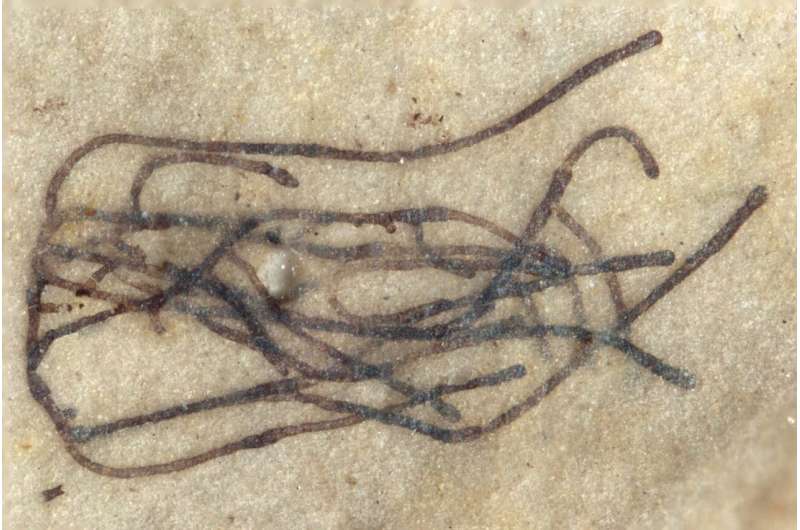One billion-year-old green seaweed fossils identified, relative of modern land plants

Virginia Tech paleontologists have made a remarkable discovery in China: 1 billion-year-old micro-fossils of green seaweeds that could be related to the ancestor of the earliest land plants and trees that first developed 450 million years ago.
The micro-fossil seaweeds—a form of algae known as Proterocladus antiquus—are barely visible to the naked eyed at 2 millimeters in length, or roughly the size of a typical flea. Professor Shuhai Xiao said the fossils are the oldest green seaweeds ever found. They were imprinted in rock taken from an area of dry land—formerly ocean—near the city of Dalian in the Liaoning Province of northern China. Previously, the earliest convincing fossil record of green seaweeds were found in rock dated at roughly 800 million years old.
The findings—led by Xiao and Qing Tang, a post-doctoral researcher, both in the Department of Geosciences, part of the Virginia Tech College of Science—are featured in the latest issue of Nature Ecology & Evolution (link not active until embargo lifts). "These new fossils suggest that green seaweeds were important players in the ocean long before their land-plant descendants moved and took control of dry land," Xiao said.
"The entire biosphere is largely dependent on plants and algae for food and oxygen, yet land plants did not evolve until about 450 million years ago," Xiao said. "Our study shows that green seaweeds evolved no later than 1 billion years ago, pushing back the record of green seaweeds by about 200 million years. What kind of seaweeds supplied food to the marine ecosystem?"
Shuhai said the current hypothesis is that land plants—the trees, grasses, food crops, bushes, even kudzu—evolved from green seaweeds, which were aquatic plants. Through geological time—millions upon millions of years—they moved out of the water and became adapted to and prospered on dry land, their new natural environment. "These fossils are related to the ancestors of all the modern land plants we see today."
However, Xiao added the caveat that not all geobiologists are on the same page—that debate on the origins of green plants remains debated. "Not everyone agrees with us; some scientists think that green plants started in rivers and lakes, and then conquered the ocean and land later," added Xiao, a member of the Virginia Tech Global Change Center.
There are three main types of seaweed: brown (Phaeophyceae), green (Chlorophyta), and red (Rhodophyta), and thousands of species of each kind. Fossils of red seaweed, which are now common on ocean floors, have been dated as far back as 1.047 billion years old.
"There are some modern green seaweeds that look very similar to the fossils that we found," Xiao said. "A group of modern green seaweeds, known as siphonocladaleans, are particularly similar in shape and size to the fossils we found."

Photosynthetic plants are, of course, vital to the ecological balance of the planet because they produce organic carbon and oxygen through photosynthesis, and they provide food and the basis of shelter for untold numbers of mammals, fish, and more. Yet, going back 2 billion years, Earth had no green plants at all in oceans, Xiao said.
It was Tang who discovered the micro-fossils of the seaweeds using an electronic microscope at Virginia Tech's campus and brought it to Xiao's attention. To more easily see the fossils, mineral oil was dripped onto the fossil to create a strong contrast.
"These seaweeds display multiple branches, upright growths, and specialized cells known as akinetes that are very common in this type of fossil," he said. "Taken together, these features strongly suggest that the fossil is a green seaweed with complex multicellularity that is circa 1 billion years old. These likely represent the earliest fossil of green seaweeds. In short, our study tells us that the ubiquitous green plants we see today can be traced back to at least 1 billion years."
According to Xiao and Tang, the tiny seaweeds once lived in a shallow ocean, died, and then became "cooked" beneath a thick pile of sediment, preserving the organic shapes of the seaweeds as fossils. Many millions of years later, the sediment was then lifted up out of the ocean and became the dry land where the fossils were retrieved by Xiao and his team, which included scientists from Nanjing Institute of Geology and Paleontology in China.
More information: A one-billion-year-old multicellular chlorophyte, Nature Ecology & Evolution (2020). DOI: 10.1038/s41559-020-1122-9 , nature.com/articles/s41559-020-1122-9
Journal information: Nature Ecology & Evolution
Provided by Virginia Tech



















